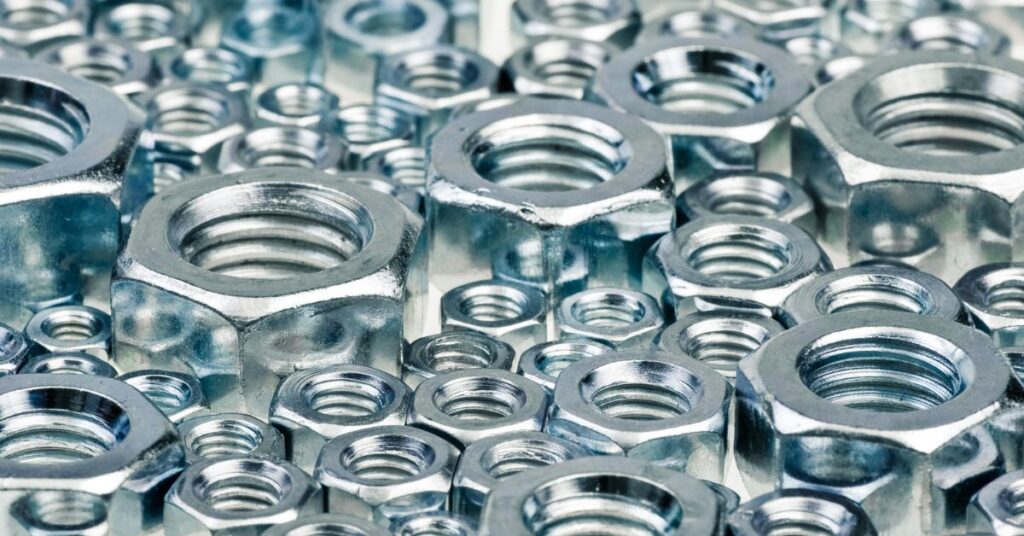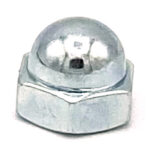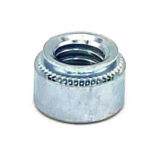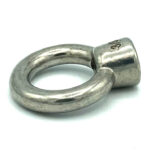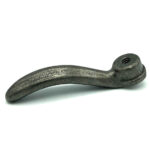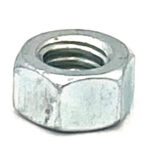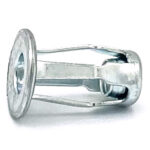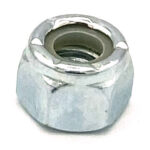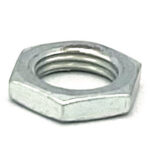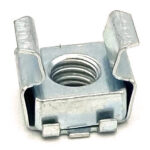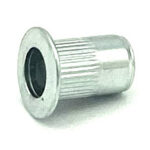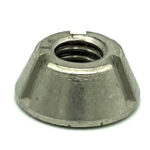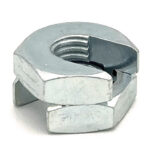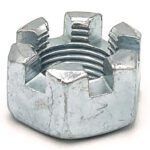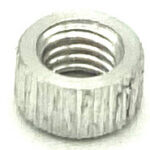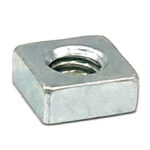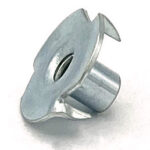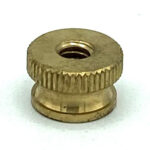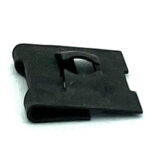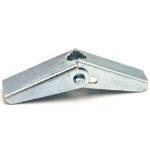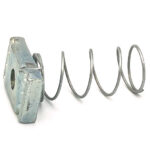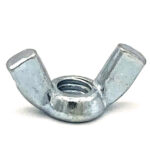Nuts keep things held together. They have a central hole that is threaded onto a mating part, like a bolt or rod, and secures the parts together. They use a clamping force and are essential for many industrial, mechanical, and construction applications. The standard hex nuts is what most people are familiar with but there is a large variety of different types of nuts each of which are designed for a specific purpose. In this article we’ll cover the main types, their uses, and relevant information to better understand the different types. Looking for a quote on a specific type? Send our sales team an email or message us via our live chat for assistance.
Acorn nuts, aka cap nuts, are hex nuts with a domed top (like an acorn). This dome covers the end of the bolt or threaded rod which provides a finished look and protects the threads from damage and debris. They are often used in applications where aesthetics are important, such as on patio furniture, bicycles, or exposed machinery.
Clinch nuts are self-clinching, internally threaded fasteners. They are used in materials that are too thin to be tapped for threads and provide a permanent thread from one side of the material. These are widely used in the automotive and electronics industries, where they are valued for their high pull-out and torque-out resistance.
Coupling nuts are basically a long standard hex nut. They are longer (also known as extension nuts) to connect two male threads together. Typically these are hexagonal on the outside to allow for a wrench to tighten them. They’re used frequently with threaded rods to join them securely.
An eye nut is a nut with a loop (aka an eye) on one end, designed to be used as a lifting or rigging point. Typically these are made of high-strength materials like stainless steel and are used in applications that require a secure anchor point, such as for lifting heavy machinery or rigging lines.
Flange nuts have a wide, circular flange at one end that acts as an integrated washer. This design helps distribute pressure over a larger surface area, reducing the risk of damage to the part. Many flange nuts have serrations on the flange to provide a locking action that prevents the nut from loosening from vibrations.
Handle nuts are fasteners with a handle that allows them to be tightened and loosened by hand without the need for a tool. They are used in applications that require frequent adjustments or disassembly, such as on machinery guards or medical equipment.
Hex nuts are the most common type of nut, featuring a hexagonal shape that is easily gripped by a wrench. These are versatile, inexpensive, and available in a wide range of materials, sizes, and grades. They’re used in a variety of applications, from construction and automotive to general household repairs.
Jack nuts are blind threaded inserts designed for use in thin and brittle materials like plastics or thin sheet metals. To install, the body of the nut collapses which forms a reusable thread. The four legs expand behind the material which provides great pull-out resistance, similar to how anchors work.
Locknuts are a special class of nuts designed to resist loosening when subjected to vibration, torque, and other forces. They come in many forms, including nylon insert lock nuts, serrated flange nuts, and all-metal prevailing torque nuts.
Panel nuts are specialized nuts designed for securing electronic panels. These are typically very thin and are engineered to provide a secure and precise fit for assemblies. They help distribute loads evenly and prevent loosening similar to a jam nut.
Also known as cage nuts, retainer nuts are spring steel fasteners that feature a square nut held within a self-retaining steel cage. The cage holds the nut in place while a screw is inserted. These are great for blind assemblies and provide a secure attachment point.
Rivet nuts (aka rivnuts or R-N nuts) are internally threaded inserts used to create a strong thread in thin materials where a tapped thread is not possible. They are installed like a rivet but provide a threaded hole, making them ideal for high-strength fastening in applications like automotive panels and aerospace components.
Security nuts are a category of nuts designed to be tamper-proof or tamper-resistant. They come in various styles, such as breakaway, sleeve/barrel, spanner, and tampruf. These often require a special tool for installation and removal. They are used to secure public fixtures, signs, and other items where theft or tampering is a concern.
Slip-on nuts are designed to be easily placed on a threaded rod at any point without the need to thread it all the way down. They open up, slide into place, and then are twisted closed and tightened, saving significant time and effort in installation.
Slotted nuts are a type of hex nut with slots cut into the top. They’re used with a cotter pin and a pre-drilled bolt to create a secure, positive-locking mechanism. The cotter pin passes through the slots and the bolt, preventing the nut from rotating and loosening. This is great for applications with high vibration.
Splined nuts (aka knurled nuts) are self clinching with an externally splined/kurled body which is designed to be pressed into the material. The splines grip the material, creating a permanent thread, which is useful in applications like panel mounts and electrical hardware.
Square nuts are just what they sound like, a square nut which has a larger surface area to contact the fastened component to rather than the standard hex nut. This makes them less likely to loosen but also requires a 90-degree rotation for the wrench. They are often used as a blind nut within a channel or in old heavy-duty machinery.
T-nuts (aka tee nuts) are a type of fastener used to anchor a bolt or screw to soft materials such as wood or particleboard. They feature a threaded body and a wide flange with prongs that dig into the material, preventing the nut from turning as a bolt is tightened. There are many variations including 3 or 4 pronged versions. They are commonly used in furniture assembly, climbing walls, and other woodworking projects.
Thumb nuts are designed with an outer knurled surface that allows for hand tightening without the use of a tool. They are ideal for applications that require frequent and rapid assembly or disassembly, such as in laboratory equipment, temporary fixtures, or camera tripods.
Tinnerman® is a brand known for its specialty fastening products, which often include self-retaining nuts that can be easily slid onto a panel edge or into a hole. These nuts are designed to simplify and speed up assembly, often serving as a cost-effective and efficient alternative to clinch or weld nuts.
Toggle nuts (aka toggle bolts) uses a spring-loaded wing or toggle to provide a secure fastening point in hollow walls or ceilings. As the nut is pushed through a pre-drilled hole, the wings open up behind the wall, creating a large bearing surface to hold a screw or bolt in place.
Unistrut® nuts are specifically designed for use with Unistrut® brand metal framing systems. They are spring-loaded nuts that slide into the channel of the strut which provides a secure and adjustable connection point for hanging or mounting various components.
Weld nuts are designed to be welded to another metallic object, creating a strong, permanent thread. There’s many variations including hex nuts, tab weld nuts (S1 series, S2 series, etc), square, etc. They’re used in applications where a mechanical fastener alone is not strong enough, commonly used in the automotive and industrial machinery.
A well nut is a rubber bushing with a threaded brass insert. It provides a sealed, vibration-resistant, and noise-dampening anchor point. As a screw is tightened, the rubber expands to create an airtight and watertight seal. They are ideal for applications in marine environments, electronics, or anywhere a cushioned, sealed connection is needed for gas or liquids.
Wing nuts have two flat wings that allow for hand adjustments. They are ideal for applications that require frequent adjustments, such as on furniture, temporary signage, or equipment that needs to be quickly assembled and disassembled.
—————————————————————
Looking for a type of nut we didn’t mention? We can probably help! Send our sales team an email with an image or description of the type of nut you need and we’ll be happy to try to find it for you!
